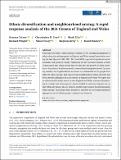Files in this item
Ethnic diversification and neighbourhood mixing : a rapid response analysis of the 2021 Census of England and Wales
Item metadata
| dc.contributor.author | Catney, Gemma | |
| dc.contributor.author | Lloyd, Christopher D. | |
| dc.contributor.author | Ellis, Mark | |
| dc.contributor.author | Wright, Richard | |
| dc.contributor.author | Finney, Nissa | |
| dc.contributor.author | Jivraj, Stephen | |
| dc.contributor.author | Manley, David | |
| dc.date.accessioned | 2023-01-17T09:30:12Z | |
| dc.date.available | 2023-01-17T09:30:12Z | |
| dc.date.issued | 2023-03-01 | |
| dc.identifier | 282974827 | |
| dc.identifier | 808940d2-5932-4691-a8a9-6eaa3075e365 | |
| dc.identifier | 000914240400001 | |
| dc.identifier | 85146323644 | |
| dc.identifier.citation | Catney , G , Lloyd , C D , Ellis , M , Wright , R , Finney , N , Jivraj , S & Manley , D 2023 , ' Ethnic diversification and neighbourhood mixing : a rapid response analysis of the 2021 Census of England and Wales ' , The Geographical Journal , vol. 189 , no. 1 , pp. 63-77 . https://doi.org/10.1111/geoj.12507 | en |
| dc.identifier.issn | 0016-7398 | |
| dc.identifier.other | RIS: urn:00A951C2AC233FD8035910E285981871 | |
| dc.identifier.other | ORCID: /0000-0001-6602-9920/work/127066333 | |
| dc.identifier.uri | https://hdl.handle.net/10023/26760 | |
| dc.description | Funding: Funding from the Economic and Social Research Council (ESRC) is acknowledged gratefully, for the project ‘Geographies of Ethnic Diversity and Inequalities (GEDI)’ (award ES/W012499/1). | en |
| dc.description.abstract | This paper provides a rapid response analysis of the changing geographies of ethnic diversity and segregation in England and Wales using Census data covering the last 30 years (1991, 2001, 2011 and 2021), a period of significant social, economic and political change. Presenting the first detailed analysis of 2021 Census small area ethnic group data, we find that the growth of ethnic diversity at the national level is mirrored across residential neighbourhoods. Increasing numbers of neighbourhoods are home to a substantial mix of people from different ethnic groups, and this growing neighbourhood ethnic diversity has been spatially diffusing across all regions of England and Wales. We argue that to understand the ethnic mosaic across England and Wales, it is more illuminating to consider mix than majority: places labelled as 'minority-majority' are, in fact, ethnically diverse spaces, home to sizable proportions of people from many ethnic groups. Increasing ethnic diversity is matched by decreasing residential segregation, for all ethnic groups-majority and minority. | |
| dc.format.extent | 15 | |
| dc.format.extent | 4153158 | |
| dc.language.iso | eng | |
| dc.relation.ispartof | The Geographical Journal | en |
| dc.subject | Census | en |
| dc.subject | Diversity | en |
| dc.subject | Ethnicity | en |
| dc.subject | Mixing | en |
| dc.subject | Neighbourhood | en |
| dc.subject | Segregation | en |
| dc.subject | 3rd-DAS | en |
| dc.subject | MCC | en |
| dc.title | Ethnic diversification and neighbourhood mixing : a rapid response analysis of the 2021 Census of England and Wales | en |
| dc.type | Journal article | en |
| dc.contributor.institution | University of St Andrews. School of Geography & Sustainable Development | en |
| dc.contributor.institution | University of St Andrews. Centre for Minorities Research (CMR) | en |
| dc.contributor.institution | University of St Andrews. Population and Health Research | en |
| dc.contributor.institution | University of St Andrews. Geographies of Sustainability, Society, Inequalities and Possibilities | en |
| dc.identifier.doi | https://doi.org/10.1111/geoj.12507 | |
| dc.description.status | Peer reviewed | en |
This item appears in the following Collection(s)
Items in the St Andrews Research Repository are protected by copyright, with all rights reserved, unless otherwise indicated.

